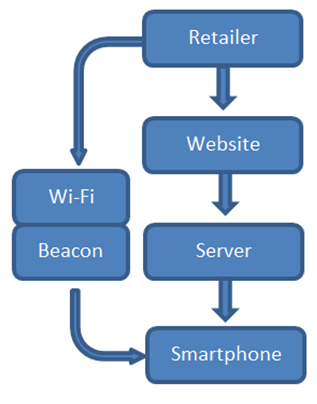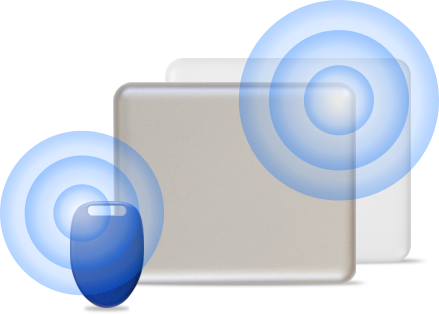BLUE Design
Problem Outline:
The core problem that many companies and store-owners need to address is how to get relevant information about their products to the correct consumers. On the internet this problem is largely tackled through use of monitoring user searches and interests through cookies, and then pushing the relevant advertisement to users based on this information. The same can be seen in other digital devices, not in least television. TV channels tend to be selective about their advertisements, correlating their marketing campaigns with the general audience of the specific channel.
However, in the corporeal world targeted advertisement is less simple, and is largely unaddressed or done in a random, not targeted, fashion. BLUE addresses this gap, by attempting to push relevant information only to relevant consumers.
Proposed solution: BLUE
Our finalised solution to this problem works by using a mobile application as a means of providing information from the producer to the consumer based on Wi-Fi location. The producer can update or alter the information the consumer received via our website. Our interactive website allows shop owners to sign up to BLUE and decide a limited amount of information which would then be pushed to the client on the application. This can be done through the use of beacon which is a technology that triggers location-aware notifications to the mobile device user. The producer is then able to tell the consumer about discounts, product information and other relevant information, while the consumer is able to access this information and more.
The potential behind BLUE lies in the versatility of the product: BLUE can be used by store owners to inform users about discounts, a translation of the menu, store mapping, and more. Most significantly, BLUE has extremely low fixed costs, and is extremely easy to set up and use.
TEMPLATES & DESIGN CRITERIA
- Current Templates of BLUE
- Design Criteria
- Ease of implementation
- Flexibility
- Effectiveness of Location Identification

We wanted BLUE to be able to produce informative, personal and commercial applications. This is how we set template goals for three different implementations of the platform. From here, some common key traits were discovered, such as a title (1), a picture to accompany and enhance aspects of the information (2) and finally basic text information to be passed on (3). It is obvious that at minimum the user must be able to design the title, include a picture, and provide text. Additionally it is worth noting that the background should be changeable. This is what BLUE can provide.
It is clear that the first and most significant design criterion of the platform is ease of implementation. By asking the people themselves, we discovered that many retailers felt that they did not have the time or experience to promote themselves effectively and professionally without using a third-party.
The second design criterion is the flexibility, in the sense that using the platform must provide as much freedom to manipulate the user interface as possible. Ideally for these criteria to be met, users cannot feel restricted in their design possibilities. The hope is that ingenuity of retailers and users will allow the platform to extend beyond simple commercial use, and perhaps be used for personal reasons too.
Finally the third design criteria is the effectiveness of location identification. In regards to this essential design criteria, retailers can target the relevant users effectively to promote themselves.
SOFTWARE
The essential working of the product can be divided into three parts:
- Website
- Parse.com
- Android Application Development
The website designed is where BLUE users or potential users can register with us to acquire the ultimate experience with BLUE, update the information as well as provide BLUE development team feedback to improve the services and performance of BLUE.
We make use of Parse.com for the client data to be stored. For the customer side, Parse offers easy to use software development kit (SDK) which integrates seamlessly with the Android application. For the client side, Parse offers a JavaScript Application Programming Interface (API) that does the necessary PHP (server-side scripting language) required. The SDK and API do all the necessary conversions between data formats to ensure that both the website and Android application can store and access information on Parse.com easily. A common application key programmed onto both the application and the website allows access to the same database from both mediums.

Android application development utilizes two communication channels, one with parse cloud storage for the data and the other with Bluetooth or Wi-Fi device for location detection.The Android application builds a list of nearby Bluetooth and Wi-Fi device MAC addresses. A 12 second scan for Bluetooth devices is used to ensure all active devices are found and battery consumption is kept to a minimum. Each Bluetooth and Wi-Fi radio has a unique MAC address which can be used to identify the device and hence the location of the user if the device is registered with BLUE.
HARDWARE
In regards to design efficient and innovative design, the hardware was designed according to the hardware design criteria. To achieve this ultimate goal, Proximity used by Gimbal bluetooth technology has been well chosen.
- High accuracy detection
Proximity used by Gimbal bluetooth technology is able to detect bluetooth mobile devices within inches.
- Low energy consumption
The battery inside the Gimbal proximity beacons can last more than two years on average, which makes our hardware design work quite a long time.
- Portable
The size of the beacon is small, roughly the same as a single coin and you can place wherever you want or take it with you.
- Affordable
Unlike other similar products in the market, Gimbal technologies is fairly cheap and reasonably priced at $5 per beacon.
- Multifunctional
The product has many potential applications as one can modify the information corresponding to each beacon. For instance, visitors going to a museum can get the information about a portrait whereas passersby might be notified of a high quality restaurant nearby.

Future developments
- Extend the application to other operating systems
- Develop more functions for BLUE and improve the interfacing for BLUE
- Enhance cooperation with retailers

So far BLUE is only available on Android OS. In order to let more people experience the simplicity and convenience of BLUE, the application will be developed onto other platforms and operating systems such as iOS.
To attract more users and make BLUE simpler and more convenient to use, BLUE needs to improved in terms of design templating. It should allow more than one image per screen and have more built in templates. BLUE can also be used for interactive forms and provide live updates when needed. Further, it should be able to use more than one Bluetooth or Wi-Fi device per account for location detection. All this is within BLUE's future design aims.
BLUE wants to cooperate with more and more retailers to fulfil its soaring ambitious and is going to be improved by taking into account feedback from users to better fit the needs of our customers.